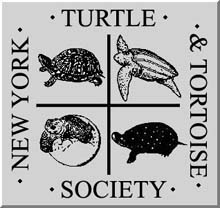 |
 |
The New York Turtle and Tortoise Society announces

Seminar 2001

Saturday, January 13, 9:00 A.M.–5:00 P.M.

The Linder Theater, American Museum of Natural History,
79th Street at Central Park West, New York City
(enter on 77th Street between Columbus Avenue & Central Park West)
|
9:00 A.M. — Registration

9:30 A.M. — Welcome and Announcements
- Suzanne Dohm, President, New York Turtle and Tortoise Society
MORNING SESSION: 9:30 A.M.–12:00 NOON
“Behavior of Solitary and Arribada-Nesting Olive Ridley Sea Turtles, Lepidochelys olivacea,
During the Internesting Period”

- Heather B. Kalb, Department of Biology at West Chester University, West Chester, Pennsylvania. Olive ridley sea turtles, in particular sites around the world, emerge en masse for synchronized nestings or arribadas. While 100,000 or more females may nest during an arribada, some females emerge out of sequence as solitary nesters. This Nancite, Costa Rica study examined olive ridleys’ internesting behavior, including their offshore reproductive activity.
“Threatened River Turtles in the Southeastern United States—An Update”

- Gregory George, Herpetologist and Designer of Reptile and Amphibian Exhibits, Chattanooga, Tennessee. Despite recent state or federal listing of many southeastern riverine turtles as protected species, the ever-changing rivers of the Southeast, collection for the pet trade, and the growing human populations of the area are still forces that shape the turtles’ future. The status of Macroclemys, Graptemys, and other significant turtle species and how they interact with the environment will be reviewed.
— LUNCH AT THE MUSEUM FOOD COURT —
AFTERNOON SESSION: 1:30–5:00 P.M.
“The Terrapin Recovery Program—Conservation Techniques to Save a Population”

- Research Interns from the Wetlands Institute, Stone Harbor, New Jersey: Jean Doherty, Kelly Hayes, and Tom Mohrman, Rowan University, Glassboro, NJ; Dana Ehret, Jennifer Wood, and Steve Emanuel, Richard Stockton College, Pomona, NJ; and Bill Sacks, Williams College, Williamstown, MA. Serious declines in southern New Jersey’s diamondback terrapin population, due to increased mortality from roadkills and crab traps, prompted the launching of the Terrapin Recovery Program at the Wetlands Institute in the late 1980s. Under the direction of Dr. Roger Wood, the program has developed techniques to incubate and hatch eggs recovered from road-killed terrapins, as well as terrapin excluder devices to prevent drowning in crab traps.
“Turtle Ecology Capacity Building for Southeast Asia”

- Jim Van Abbema, New York Turtle and Tortoise Society, and Minh Duc Le, Center for Biodiversity, American Museum of Natural History. The goals of the new scholarship program for Southeast Asian students are to develop scientific expertise for chelonian research as well as the capability to establish and direct conservation education and awareness programs throughout Southeast Asia — critical factors for the future of turtles in Vietnam and other Southeast Asian countries. Minh Duc Le has already begun to play a significant role in this effort (See “Turtles in Trouble: Viet Nam’s Wildlife Is Being Traded Away”).
“Vietnam: The Hunt for Rafetus swinhoei—the World’s Rarest and Largest Freshwater Turtle”

- Peter C. H. Pritchard, Chelonia Institute, Oviedo, Florida. Perhaps the world’s most elusive turtle is Hanoi’s legendary Hoan Kiem Lake giant softshell, rarely seen but of great cultural significance to the Vietnamese people. There may indeed be only one of these giants left in the lake, but others have been documented in the country’s northern lakes and rivers. In November, Peter Pritchard toured the northern provinces up to the Chinese border and returned with videotaped interviews and slides documenting his findings.
|
|
Heather B. Kalb (Department of Biology at West Chester University, West Chester, Pennsylvania) received her Ph.D. from Texas A&M University where she studied olive ridley sea turtles. She founded the Box Turtle Research and Conservation Newsletter, now combined with Chelonian Research Foundation’s Turtle and Tortoise Newsletter, which she co-edits with Allen Salzberg. Heather currently teaches in the Department of Biology at West Chester University, in West Chester, Pennsylvania.
Gregory George (Herpetologist and Designer of Reptile and Amphibian Exhibits, Chattanooga, Tennessee) has been a reptile keeper/herpetologist at the Atlanta Zoo, the Roger Williams Park Zoo, and the Tennessee Aquarium. He has long served as a working member of the IUCN Freshwater Turtle and Tortoise Specialist Group and as a member and chairperson of the American Zoological Society Amphibian Advisory Group. Since 1998 he has been designing and constructing naturalistic reptile and amphibian exhibits for zoos, aquariums, and museums.
Research Interns (The Wetlands Institute, Stone Harbor, New Jersey). Each summer the Wetlands Institute conducts an intensive internship program for college students and recent graduates. Interns work closely with Dr. Wood and receive a practical laboratory and field course in hands-on conservation. Research interns from this past summer give us a behind-the-scenes look at their day-to-day (and through-the-night) research activities.
Peter C. H. Pritchard (The Chelonia Institute, Oviedo, Florida) is well known to every turtle afficionado for his Encyclopedia of Turtles and The Turtles of Venezuela. A regular speaker at our Annual Seminars, he returns again with another report of his ongoing quest to find, in the wild, all the world’s turtle species.
|
|
We are very pleased to hold Seminar 2001 at the American Museum of Natural History. On Manhattan’s Upper West Side, easily accessible by public transportation, the Museum has been the site of our regular monthly meetings for nearly 20 years. It’s newly renovated parking garage is also now available. Visit the Museum’s Web site at www.amnh.org.
|

|

